The newly founded European Media Art Platform – supported by the Creative Europe Programme of the European Union – has selected eleven media artists and groups for its first Open Call, who were able to do a residency in eleven different countries during the course of this year. Until December 3rd, 2018, EMAP/EMARE will again be looking for media artists in the digital media sector – more information on the Open Call at call.emare.eu. In 2018, Robertina Šebjanič and Gjino Šutić visited Ars Electronica as part of their residency. The result is the project aqua_forensic, which they presented at the 2018 Ars Electronica Festival in Linz, and which is now going through further rounds. We asked them to introduce us to the project and tell us how they work in the fields between art and science.
What’s the aqua_forensic project about?
Robertina Šebjanič: With the project aqua_forensic we want to open up a discussion about invisible anthropogenic pollution in the world’s water habitats.
We have been working on this project in the frame of the EMARE/EMAP residency programme in the summer of 2018. At Ars Electronica in Linz we conducted a research at the Danube River, and in Dubrovnik we explored the Adriatic Sea. In both cases our special focus was on finding and analysing chemical pollutants such as pharmaceutical residues.
The main challenges of aqua_forensic has definitely been finding a way to represent the invisible pollutants, so-called “monsters”. We wanted to clearly point out that our mission is a “hunt for a phantom”. When talking about chemical pollutants their appearance is without tangible material substance. But we were wrong – they exists and on the chemical level they are integrated into marine life and consequently will end up in our human bodies throughout the food chain…
We would like to articulate principles of showcasing pressing ecological issues of the world and ways to deal with these challenges from the perspective of today’s knowledge as well as future prospects. Furthermore, we aim to present the results of this scientific research to the wide audience in a poetic and artistic way. During the residency we have developed various chemical and biological DIY protocols of how to analyse water and mud samples.
Gjino Šutić: In the future we would also like to work on a conceptual prototype for a user friendly underwater drone and a molecular probe kit for accurate field research of underwater pollution – an upgrade of the Open ROV kit that we used for exploration and sample collection from the water, with the emphasis on exploration of water pollution and its impact on marine life. One of the goals of the project aqua_forensic is also raising awareness about water pollutants and finding a way for reducing and/or upcycling them.
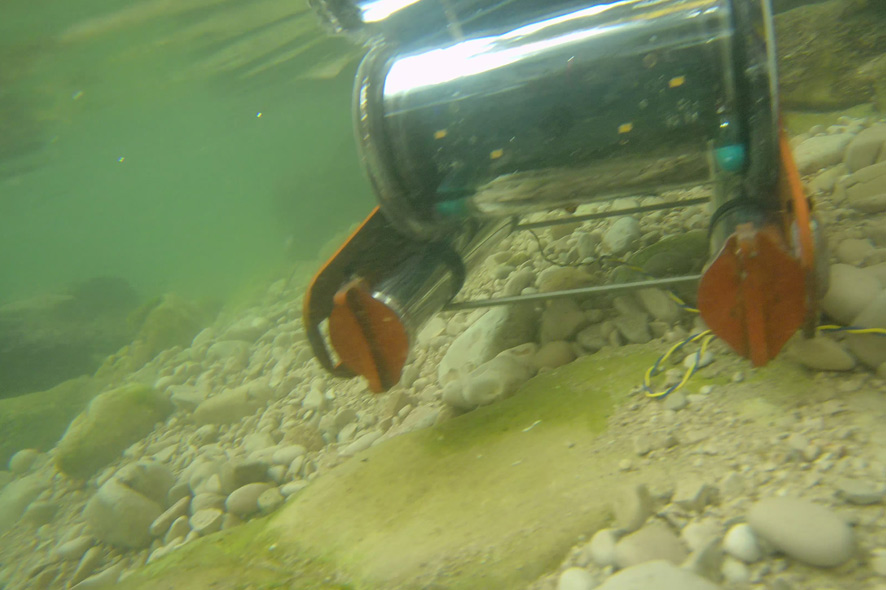
The project is showcased as a combination of installation, workshop and public discussion with intention to create new narratives in this art and science dialogue. The installation connects copper pipes and holographic videos showing the moment of the in vitro experiments of microorganisms dying in the 20.000 times weaker solution of pharmaceuticals from the average human dose. It shows what kind of impact we have on water habitats and their life, from micro to macro levels. The pipe system of the installation connects all these elements into an immersive environment, where the viewer is intertwined with them and invited to look closely at the “modules” where the video hologram are presenting microorganisms dissolving in various pharmaceuticals – results of in vitro experiments conducted at UR Institute laboratory in Dubrovnik.
The book documents the research, conducted at the 2018 residency in Linz and Dubrovnik, of these invisible chemical pollutants (mood controllers, antibiotics, antimycotics, painkillers, hormone pills, etc.).
How did you come up with this topic and research?
Gjino Šutić: I have always been interested in invisible & unexplored realms of nature… With my background in biotechnology & chemistry and affinity to citizens science practices and BioArt, I have been playing around for a while with unorthodox and innovative approaches to ecology & forensics. My first art project on this topic was “The Moment of Death” done with my colleague Tanja Minarik in 2014 for Touch Me festival in Zagreb. In this project we explored ecology of death, giving the audience sensory and empathic experience of death through really complicated techno biological art installation.
Robertina and I have been collaborating on several projects with related topics since the same year – for example at HackteriaLab 2014 in Indonesia or the Piksel festival 2015 in Norway. On HackteriaLab we focused on exploring environmental pollution of different ecosystems and share some ideas that we could collaboratively explore. On Piksel festival 2015 we had the first opportunity to collaborate on novel invisible water pollutants (micro plastics and underwater noise pollution) – project “Pikslo_deep_diving / Underwater interception of the nordic sea” was done with colleagues Robertina Šebjanič, Kat Austen & Slavko Glamočanin. These collaborations opened a discussion on pharmaceutical pollution, so that we finally got the opportunity to explore more – with amazing support of Ars Electronica and EMAP/EMARE framework.
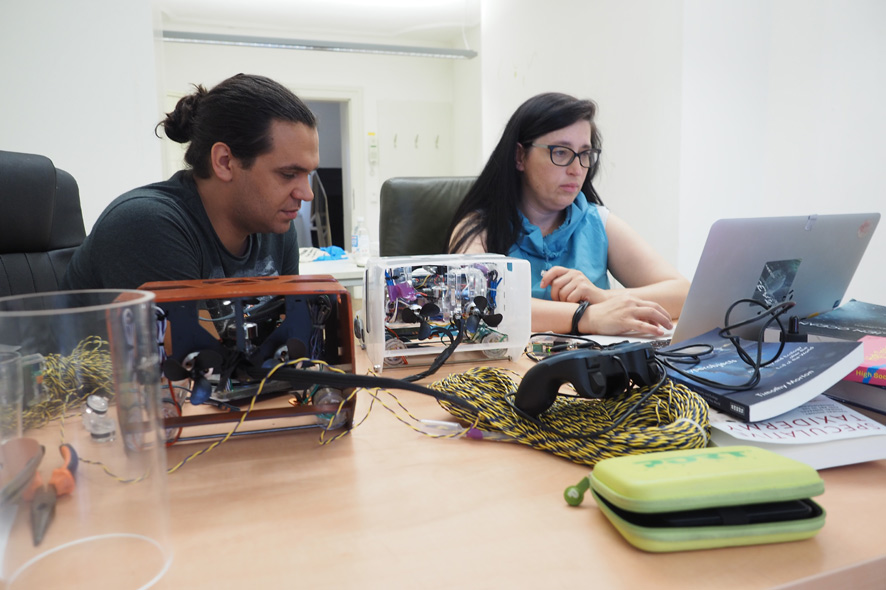
Robertina Šebjanič: In the past couple of years I focus on different viewpoints of cultural, (bio) political and ecological issues of aquatic environments. In the past, i.e. in frames of the Aquatocene project, I have already explored challenges and effects of underwater noise pollution caused by human presence in oceans and seas. Furthermore, for several years I have worked on “Aurelia 1+Hz” dealing with the relationship between humans, marine animals and machines, and with the interspecies’ communication. Already then I was also curious about the impact of pharmaceuticals on the environment.

However, working with the underwater habitats, despite being inhospitable for humans who can survive in water longer and deeper only with support of technological devices, is challenging but also rewarding at the same time. In the last decade I have had an amazing privilege to be working with scientist, experts in marine institutes and private aquariums and I learned that there is still so much unexplored and unknown about world’s oceans and seas.
For some time I have been thinking a lot how to start the research on the relationship between pharmaceuticals, humans and environment. When talking to my collaborator Gjino Šutić, with whom I share common interest for these topics, about possible directions and starting points it all slowly started to make sense. Then we applied to the EMAP/EMARE open call and we were selected for a residency programme here at Ars Electronica.
Why this topic in particular?
Robertina Šebjanič: One of the main reasons why I think it is important to work on such research project is the fact that the humankind is changing the waters inside out and that nobody knows what the consequences of this aqua forming will be in the next decades. As our bodies cannot consume the entire substance of pills we intake; in rough estimation around 20% of it stays on our bodies and around 80% is released to the sewage and consequently into oceans and seas. Optimisation of our intake would be necessary and, as mentioned before, also fish farming contributes to huge quantities of antibiotics and similar pharmaceuticals in water habitats. That is the reason I started to use expression “aqua forming” which is a term describing waters with anthropogenic pollution which changes basic composition of water habitats, on a nano and macro level.
The positive side of the collaboration with Gjino Šutić is, that we have different perceptions of understanding water habitats. I think it was a great thing to combine our knowledge and workflow. Until now it all went really smooth; we both like to share our expertise between each other and with other collaborators who helped us with the research and execution of the aqua_forensic project.
One can therefore say that we as humans should consider the habitat of water much more important than before…
Robertina Šebjanič: The human impact on water habitats is enormous. Plastic and micro-plastic waste is everywhere, even in the deepest and darkest corners of oceans, and that is a very telling and alarming fact. The enormous pollution is, of course, the direct result of huge production and consumption in all global industries, especially fishery, marine farming, marine transport and extraction of oil drilling, which shows possible ways to change brutal exploitation of the environment that we know from the past and from the present.
I believe now it is a good moment for a profound introspection that would (hopefully) eventually lead to pharmaceutical which would be friendlier to our bodies as well as to the environment. Agricultural industries are looking into new more sustainable options of food production and there is lot of interest nowadays to move farming into the (under)water habitats.
“The magnitude of environmental problems that planet is facing nowadays is ever more concerning and therefore there is a complex combination of economy, scientific development and geopolitical interest that needs to be tackled in upcoming years in order to preserve the water habitats.”
Could you please explain the term biotweaking to us? What’s that concept about?
Gjino Šutić: My work is highly interdisciplinary, combining different scientific disciplines with art, education, citizen science & DIY practices, but mostly in some way it is always connected with biotechnology (and DIY biotechnology). So when people asked me “what do you do?” expecting one word reply, I had problems giving it to them, so I coined the term that describe both my practices as well as philosophy.
Biotweaking term describes acts (or art) of improving biological organisms on any level, by available means, to exhibit and use their full potential. It is derived from Greek word bios = life + English verb tweaking = fine-tuning or adjusting a complex system (usually an electronic device). Tweaks are any small modifications intended to improve a system.
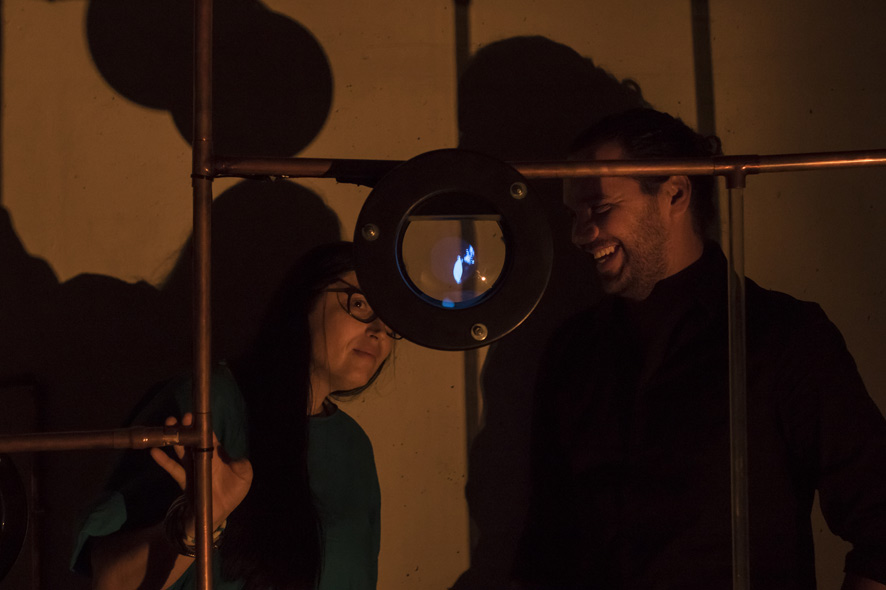
And what is the meaning of the term aquatocene that you use?
Robertina Šebjanič: Aquatocene is a term that I coined to be referring to the aqua forming in the Anthropocene era. When talking about the aquatocene – I talk about the challenges that are happening with rapid changes in world’s oceans and seas mostly done by us humans and our imprint. I try to work long-term on the issues referring to the ecology of water habitats from biological, chemical and geopolitical perspectives.
The project is ongoing from 2016 when, with Aquatocene / Subaquatic quest for serenity, I started to investigate the phenomenon of underwater noise pollution created by humankind. The audio compositions of the subaquatic soundscape encourage the listeners to reflect upon the anthropogenic sonic impact on the underwater habitat and marine life, as well as illuminate awareness and underscore the importance of maintaining safe sound environments for animals living in the world’s oceans, seas, lakes and rivers. The sound compositions are a re-mix between the bioacoustics of marine life (shrimps, fish, sea urchins etc.), the aquatic acoustics and the presence of human generated noise in the world’s oceans and seas. Aquatocene / Subaquatic quest for serenity was published as a triple album in 2016 and you can listen to it on my Bandcamp.
In my work I often create series of work for which I spent significant amount of time on preliminary research. I would say that my previous projects range from future speculations of plant – human relationship and rethinking new trans-species (Humalga), animal-machine-human relationships, regenerative medicine, “hunt for eternal youth”, inter-species communication (series of works Aurelia 1+Hz), sonification of the chemical process (Time Displacement), and pointing out underwater noise pollution and its ecological consequences (Aquatocene).

In your proposal you are asking the question if the ocean could supply us with new therapeutics – what exactly do you mean by that and is that possible?
Robertina Šebjanič: As mentioned before there is still so much unexplored in our water habitats. I am sure that there is a lot of potential which is at the moment still unknown to us; however, my biggest concern is that we are still not aware that water habitats have to be handled with a caution. As the economic interest are huge again, as they were in the previous periods of world history such as first and the second industrial revolution, we may expect repetition of previous mistakes. With the development of biotechnology the commercial industries are prospering, however, there are many ethical questions coming up. Well, I know I sound dystopian but I think that the zeitgeist is leaning more towards the darker interpretations of the future. What would be really needed is a good coordinated geopolitical strategy to start treating our water habitats with greater attention then we do now.
Gjino Šutić: As an biotechnologist & artist living by the sea I can’t not to look at the sea as a potential. Spending whole childhood snorkelling around costs of Dubrovnik I was always spending a lot of time researching marine biology through practice, and I was surprised how little we know about it. I never had interest in objects in plain sight such as fish. Searching for parts (& mechanisms) of nature that are hidden intrigued me more.
Science is still dealing with cataloguing vast number of marine organisms, and we have just started to get insight in potential that lies there. We know a lot about large organisms, algae & plankton they eat, but still lack developed methods to explore organisms such as marine bacteria and fungi which I find most fascinating.
We have just scratched the surface in exploring biomedical potential of the sea, but it shows huge promises – anticancer potential of drugs derived from sponges, regenerative capabilities of starfish and even using fish skin in xenotransplantation (substitute skin to treat burns etc.). Exponential intense growth in aquaculture since 1960s (Blue Revolution) has not stopped.
Because all of that, I believe that the future lies in this direction – that is why I opened biotech and aquaculture company in Dubrovnik few years ago (Gen0 Industries), not just to do biotechnological research and development, but also to explore cybernetics of the sea.
“I think we should look at the sea not just as a consumption resource but also as a case study of complex system behaviour. We can learn so much from it, and apply this knowledge for making new solutions in industry & everyday life.”
What had been your plans for the residency and what was your goal during the EMAP/EMARE residency?
Robertina Šebjanič: During the residency, the goal was to clear up the concept; so first of all we have been reading and researching a lot. Also we had made many experiments, either chemical or in-vitro, and building an upgrade of underwater drone. We have taken many samples from the Danube and Traun rivers in Linz and from the shores around Dubrovnik in Adriatic Sea.

Especially the session we conducted with in-vitro experiments at UR institute in Dubrovnik did help us to pin down the conceptual framework for the exhibition at Ars Electronica festival in September 2018 where the installation aqua_forensic was shown for the first time. The next step in the process is an artist book that will be launched at the Ars Electronica Export exhibition at DRIVE. Volkswagen Group Forum in Berlin in November 2018.
In the installation and in the book we are presenting the images that were created in laboratory conditions in a series of in vitro experiments; these have been carried out on 30 microorganisms exposed to 16 pharmaceuticals (mood controllers, antibiotics, antimycotics, painkillers, hormone pills, etc.). The pharmaceutical we decided to look first was the ones that are used a lot on daily basis. That is a personal touch we decided to add to the project in order to be aware of the situation and to be aware we are also part of this issue. We simply can’t exclude ourselves from that phenomenon; our view on a society is always subjective.
The experiments were repeated three times for validation – it took more than a month to make them all in correct conditions. The concentrations of drugs used were between 20,000 times smaller than the ones we use for human dose (addition of 5µl and 10µl of stock solution – human dose of drug diluted in 100ml of water). The in-vitro experiments were laboratory reconstructions of real data reflecting the daily consumption of pharmaceuticals by microorganisms demonstrating how much of these materials is ending up in the world’s waters.
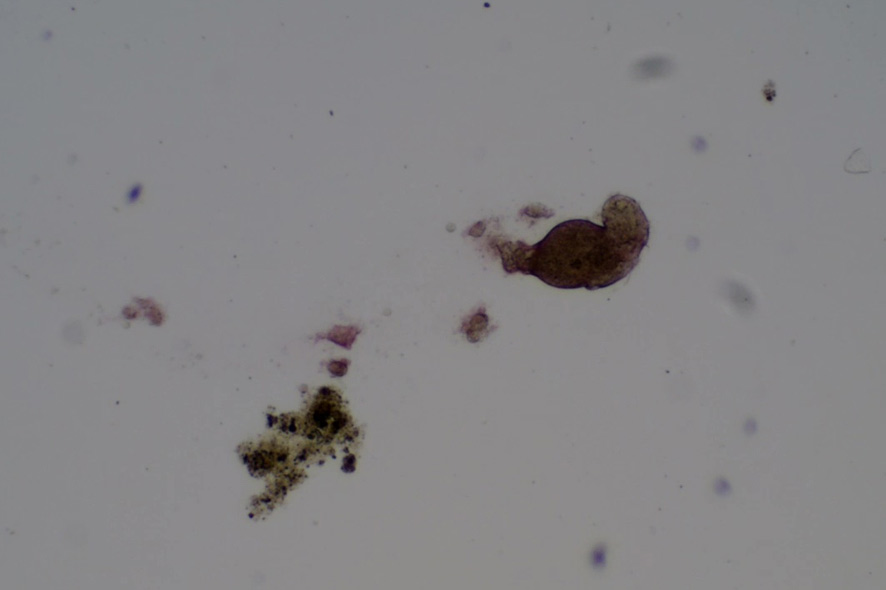
The videos and images that are on show within the installation aqua_forensic show the disintegration process of microorganisms – or we can say that they represent the moment of their death. With the project we hoped to attract attention and to open the debate but we also developed a workshop which will initially take place in Bourgues, France at Bandits-Mages; furthermore, there are plans to conduct it next year in Berlin.
It was also great to have an extra help of the colleagues at the UR institute – Antonia Merčep and Lovro Martinović, as well as of my close collaborator Miha Godec. The project was supported by Projekt Atol institute which enabled us to build the installation at our temporary studio at Osmo/za in Ljubljana.
During this summer / autumn research and development process we had a great support of the entire Ars Electronica team and we are very grateful for their amazing support and also guidance in the intense residency programme and production process.

Gjino Šutić: The residency gave us wonderful opportunity to explore our ideas in theory and practice, do a lot of brainstorming and learn in the most simulative environment.
Going into experiments of observing effect of pharmaceuticals on microorganisms we did not expect results this intense. This moments of death – “micro explosions” of the protozoans captured on videos – the main artefacts of our research where just stunning – beautiful & sad at the same time. I wished that this pollution issue is not so intense, but now at least we know that we need to work on solving it.
I’m really satisfied with our work since it produced wonderful art installation that serves its purpose – communicates the story that we are trying to tell.
Installation is made of copper pipes that with copper as antimicrobial material and pipes as a way of humanity to try to control the water, give a proper framework of the story. And the central pieces – the multimedia part (holographic looking glass into the pipes) – are showing glimpse in this invisible graveyard that we are producing through negligence.
I’m also really satisfied that the residency has incubated also two science papers that we will try to publish & share our data with scientific community. One of the most fulfilling parts of the residency was also the opportunity to make new friendships – connect with likeminded people in constructive way and form new partnerships in developing these and related topics. The residency has opened more questions and doors to new research that we would like and are planning to explore from science and art perspectives.
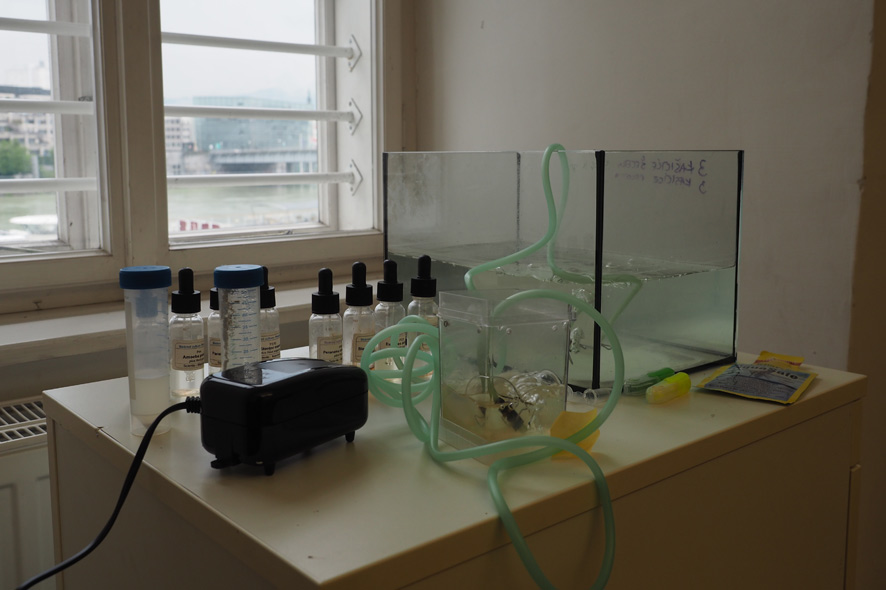
You both work in the cross field of art, technology and science. What are the benefits that you derive from this intersection?
Robertina Šebjanič: The importance in working on art, science and technology is to try to find some other imperatives – that are not only a science communication or simplification of something complex. Combining different disciplines can be very challenging and rewarding at the same time. Transdisciplinary thinkers take a unique approach to solving problems. Both science and art are human attempts to understand and describe the world around us. The subjects and methods have different traditions, and the intended audiences are different, but I think the motivations and goals are fundamentally the same. For me it’s easiest to answer on this question with my way of working.
Each of my projects, and its research process, is specific and I try to see what disciplines I would need to combine to get the most of it. In last decade I was intensely collaborating and working with many marine biologists in various Marine institutes. I think that in my way of working – is the most difficult thing is to figure out basic parameters even before the collaboration process starts. Once the concept and the methodology of the research are clear, nearly half of the work is done. When it comes to exhibitions I always try not to simplify scientific research behind the project. That is the reason why I often organise symposiums to accompany my exhibitions and audio-visual performances. These events open up the topic and hand over the podium to all agents involved.
“In the past years I noticed strong empowerment of citizens’ science as well as that there are ever more scientific papers having open access to their published articles. I think that there is an excellent progress happening and that there is a sense of empowerment raising up. I do believe that the knowledge should be accessible to everybody, not only to the privileged ones.”
Gjino Šutić: I think the most creative potential comes with combining different fields. And science, art & technology I just can’t look at as divided fields. Maybe it is some short circuit in my mind, but for me these fields have always been merged. There is no one without the other. This interconnected trio are the basic pillars of culture & civilizational development, and our personal as well (as a species). We coevolve with our tools (technology) leaving science & art (words and images) as footprints of that evolution. Should we separate ourselves from the nature or merge with it in symbiotic way in that process is the only question to be answered.

The aqua_forensic project will be presented in Berlin (November 17th, 2018, to February 17th, 2019) at the ERROR – The Art of Imperfection exhibition by Ars Electronica Export at the DRIVE. Volkswagen Group Forum. From November 23rd, 2018, to December 30th, 2018, at “A World Without Us“, Impakt, Nederlands and December 2nd, 2018, at Bourges – part at group exhibition Mending the Fabric of the World, curated by Annick Bureaud at Bandits-Mages.

Robertina Šebjanič (SI) is an international exhibited artist. Her artistic work deals with cultural, (bio)political and ecological realities of aquatic environments. With her projects she tackles the philosophical questions at the intersection of art, technology and science. Her projects are often realized in collaboration with others, through interdisciplinary and informal integration in her work.
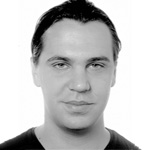
Gjino Šutić (HR) is a biotechnologist, post-modern intermedia artist, innovator & educator. He is the funder and director of Universal Research Institute & Gen0 Industries. Gjino conducts research in several fields of science ( such as; biotechnology, bioelectronics, experimental electronics, ecological engineering ) and postmodern new media art ( Bio Art, Digital art, Installation art, Multimedia Art & Hybrid Art ).
